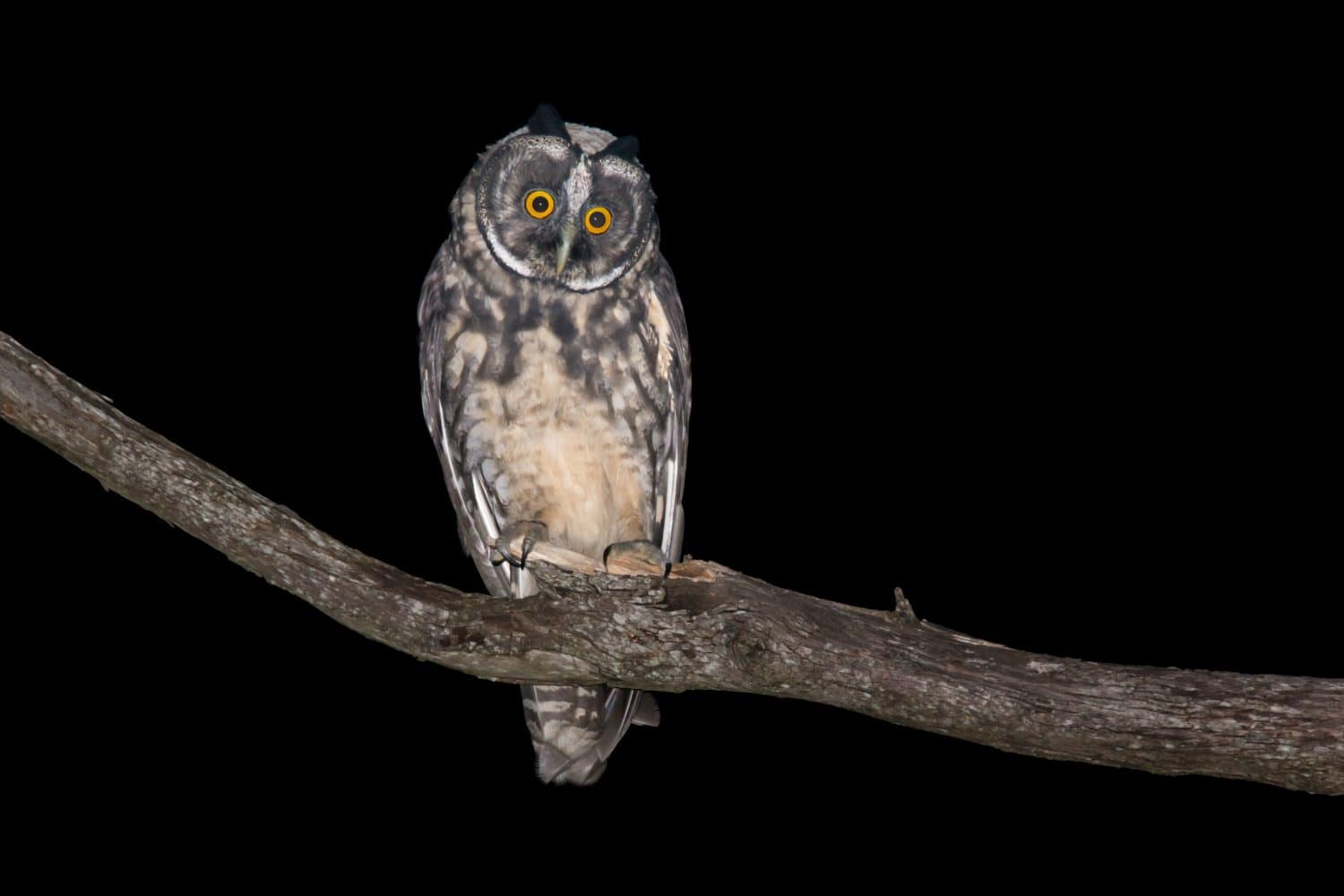Many people consider owls intriguing creatures. Numerous cultures revere these birds. Often thought of as wise and strong, certain nations and peoples take such admiration to mythical proportions. One particularly fascinating creature is the stygian owl. Discovering the stygian owl is an interesting and ongoing process for many.

Stygian owls are considered mysterious because of their unique appearance, as well as the fact that not much is known about them.
©Leandro Espino/Shutterstock.com
Name Origin
In scientific terms, the stygian owl is known as Asio stygius. The word stygian hails from the Greek language and means dark and gloomy. Additionally, stygian pays reference to the River Styx. In Greek mythology, this body of water served as a crossing from where departed souls entered the underworld.

The stygian owl’s unique looks inspire some people and cultures to call it the devil owl.
©ABnatureza/Shutterstock.com
Appearance
Stygian owls hold a reputation for possessing a dark, almost devilish look. Specific features include:
Coloring
The bird’s body contains markings such as:
- A brownish face
- A black bill
- A dark brown upper body
- A mixture of brown, black, and grey feathers
- A dark brown tail
Arguably, however, the stygian owl’s most distinctive features are its eyes. These piercing components glare out at those looking back with deep yellow and orange coloring. When exposed to light, these eyes often appear red.
Size
The creature’s body extends anywhere from 15 to 18 inches in length. Typically, females are larger than their male counterparts.
Weight
Stygian owls weigh in at roughly two to three pounds. Once again, females typically weigh more than males.
Wingspan
These birds possess large wings. Therefore, their wingspans usually spread out to 40 inches or more.
Communication
Males and females voice different calls. The males communicate with females using deep-pitched vocalizations. Females respond to male calls by offering louder, more shrill voices. When agitated or excited, all stygian owls’ put forth a sound similar to wak-wak-wak. Young birds chirp when hungry.
Behavior
The stygian owl displays nocturnal tendencies meaning that they carry out almost every important function during the evening hours. Specific activities include hunting, feeding, and migrating.
When comfortable, these birds possess an uncanny knack for blending into their surroundings. Occasionally, they mesh so well with their environment that they become nearly invisible. However, when they feel threatened, the stygian owl stands upright with its ears raised.
This bird species does not flap its wings frequently when flying. Rather, stygian owls glide for extended periods covering notable distances.
Habitat
Relatively sizeable populations of stygian owls live in both mountainous regions and humid locations like rainforests and the tropics. Specifically, the species has been spotted brooding in geographic regions such as the Caribbean, the southern portion of North America, Central America, and South America. Specifically, the birds frequent countries including:
- Mexico
- Nicaragua
- Belize
- Panama
- Colombia
- Ecuador
- Paraguay
- Argentina
- Venezuela
- Brazil
Stygian owls have also been seen in Haiti, the Dominican Republic, and Cuba.
Diet
The diet of this bird varies. Unlike other owl types, the stygian variety does not typically feast on rodents. However, the species consumes mammals, especially bats. The bird also consumes amphibians like frogs and insects such as crickets, beetles, and grasshoppers.
Furthermore, stygian owls partake in a feeding phenomenon known as intraguild predation. Animals engaging in this practice eat creatures representing their own species. Researchers cannot pinpoint why stygian owls consume other similar creatures. However, some believe the act occurs as a means of eliminating similar animals from competing for limited food sources.
Conservation Status
Presently, the stygian owl is listed as a species of least concern by the International Union of the Conservation of Nature, sometimes abbreviated simply as the IUCN. That said, researchers attribute this to the fact that there has not been a significant amount of information gathered about these creatures to determine how abundant the species truly is.
However, researchers believe the world population is slowly declining. Moreover, certain nations have placed the bird on protected lists. For example, in Mexico, stygian owls are listed on the Endangered Species Act. The Brazilian government afforded the birds safe harbor under the Brazilian Wildlife Protection Act. This piece of legislation prevents them from being injured, captured, hunted, or traded for profit.
Reproduction
Researchers claim to lack enough information to draw any firm conclusions about the stygian owl’s reproductive habits. However, those possessing some degree of knowledge maintain that the creature usually does not construct its own nests but uses those built by other birds.
Furthermore, females typically lay two eggs, which are incubated for 30 days. Both parents feed their young. Breeding also seems to coincide with the rainy season of the specific nation or geographic location that the birds live in. Observers suggest that stygian owls nest between March and November.
Why is The Stygian Owl Considered so Mysterious?
Observers credit the bird’s unusual and dark features for its mysterious reputation. Some cultures even believe the creature possesses devilish or demonic qualities. For example, in Brazil, the bird is labeled coruja-diabo, which means devil owl in Portuguese.
The photo featured at the top of this post is © J Esteban Berrio/iStock via Getty Images
Thank you for reading! Have some feedback for us? Contact the AZ Animals editorial team.







